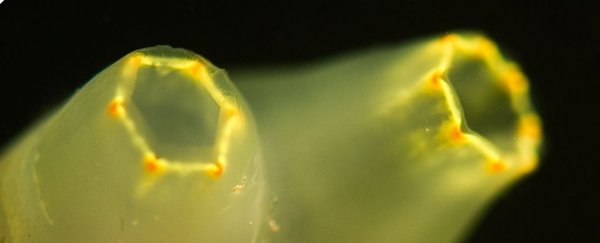What's in a head? According to new research, a little bit of our ancestors' tails.
In the early days of complex, multicellular life on Earth, animals started out without any spines or brains. They only had a network of neurons spread throughout their body. Over the course of millions of years, however, that system somehow became concentrated on one end. But how?
Tunicates, or 'sea squirts', are the closest living relatives of vertebrates, and they don't have a true head.
Their central nervous system is instead made up of clumps of neurons in the anterior and posterior parts of their body, with a dorsal strand connecting them both. As adults, these animals look like stagnant sponge-like blobs, with no clear head or tail. But as tadpole-like larvae, their cerebrum is easier to make out.
"Tunicates are like an evolutionary prototype for vertebrates," explains zoologist Ute Rothbächer from the University of Innsbruck in Austria. "Our common ancestor was probably very similar to a tunicate larva."
 PIC Tunicate tadpole showing bipolar tail neurons (green). (The University of Innsbruck)
PIC Tunicate tadpole showing bipolar tail neurons (green). (The University of Innsbruck)
Not all evolutionary scientists agree with this: It's a contentious area of research. But Rothbächer and his colleagues have recently found evidence to support their ideas.
Their research has found Hmx genes, which encode for a pair of neurons in a tunicate tadpole's tail, are related to the genes that encode for clumps of neurons in a lamprey's head.
Lampreys are considered 'living fossils' because they have been around for so long with little change to their species. These marine animals are some of the first vertebrates, and they look sort-of like eels.
The evolutionary jump from tunicate life to lamprey life was a big one, but the Hmx gene seems to have made it across the divide. Its effect is just slightly different among vertebrates.
When splicing the Hmx genes of a lamprey into a tunicate species called Ciona intestinalis, researchers found the gene helped drive the expression of bipolar tail neurons.
In lampreys, however, the same genes helped drive the expression of sensory neurons in the cranium.
Despite impacting nerves in different parts of the body, the similar function of Hmx genes in lampreys and tunicates suggests they have a common evolutionary origin and might have played a role in the centralization of the nervous system.
"Hmx has been shown to be a central gene that has been conserved across evolution," says zoologist Alessandro Pennati, also from the University of Innsbruck.
"It has retained its original function and structure and was probably found in this form in the common ancestor of vertebrates and tunicates."
The findings suggest vertebrate brains might have once been recycled from the apparatus of their ancestors millions of years ago. And now, here we are.
The study was published in Nature.
